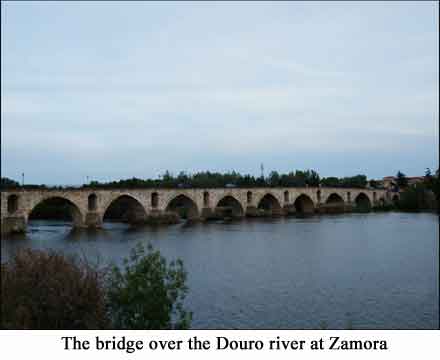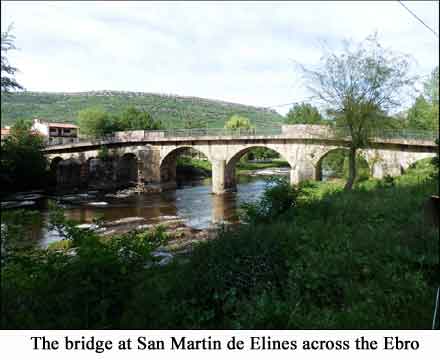
Chapter 41
The Advance to Vitoria
May-July 1813
The General Marching Order
for all the allied Divisions was issued on May 13th 1813.
General Graham, who had recovered from his eye infection
and just returned from England, leading 6 Divisions crossed
the Douro, this time far inside Portugal and was in and
around Braganza and Miranda up
on the Spanish border between May 21st and 24th. The 1st
Division marched from Vizeu, the 5th, 6th and 7th Divisions
from their winter quarters in the Beira, the 3rd and 4th
Divisions from close to the Douro at Maimenta and St Joao
de Pesqueira, all crossing the Douro by pontoon bridge
at Pieso de Regoa, St Joao de Besqueira and the Barca
of Pocinho. However Pack and Bradford’s Portuguese
Brigades had wintered north of the Douro at Penafiel
and Villa Real and so had less distance to travel and
were at Braganza on the 21st May before the heavy column
came up, together with D’Urban’s Dragoons
who had wintered there. In addition 33 pontoons were brought
overland from Abrantes, sending 14 to Espadacerita and
19 to Villa al Campo – a mile below the confluence
of the Esla and |
 |
Douro.
On the 26th the whole of Graham’s Corps started
out in 3 columns from Braganza, Outeiro, Vimioso, and
Miranda de Douro. Pack’s brigade marched with the
northern column from Braganza with Anson’s Light
and Ponsonby’s heavy dragoons and the 1st Infantry
Division. They crossed the Spanish frontier river Monzanas
at fords near the Spanish village of Nuez,
then by four marches to Tabara via Sesnandez. The Cavalry
reached their destinations of Tabara, Losilla and Cabajales
on May 28th and the infantry the following day, 29th May.
Meanwhile between 20th and 26th May, Wellington and Hill
were attracting most of French attention when with 3 Divisions
they moved from the Agueda river towards the Tormes river,
until after halting at Salamanca for a few days they swerved
off to the west and joined up with Graham by the bridge
at Toro, thus establishing the whole army in one mass
north of the Douro. Wellington had left his HQ at Frenada
on 22nd May and rode to Ciudad Rodrigo and then |
joined
Hill on 24th when Hill's right wing
was combined. On 25th the HQ was at Matilla and by 26th
was around Salamanca. Hill now halted for six days. On
May 28th Wellington left Hill in command of the Right
wing with instructions to head for Zamora as soon as he
heard that Graham had crossed the Esla, bridges would
be available there. At dawn on 29th May Wellington rode
off to the northwest to join Graham, he rode a distance
of 50 miles in one day arriving on the opposite bank of
the Douro to Miranda before dark. The only way of crossing
was by a rope and basket high above the river gorge. He
slept at Miranda and rode to Carvajales 20 miles away
the following day. His first decision was to lay the pontoon
bridge not across the Douro at Villa al Campo but on the
Esla opposite Almendra where the high road from Puebla
|
Senabria to Zamora crosses
the river. The French were still pre-occupied with Hill’s
right wing opposite Salamanca and had no suspicion that
an army of 40,000 was about to cross the Esla and turn
their right wing. By June 1st the French had evacuated
Zamora and Wellington was able to enter and make it his
headquarters, and ordered Hill to march on the town of
Toro. Wellington arrived at Toro on the 2nd June and was
able to secure the area in readiness for Hill’s
arrival on 3rd June. By the 4th June, the entire army
of 80,000 was on the North bank of the Douro at Toro.
The French were aware by 1st June that Wellington had
crossed the Douro and began to move their army north of
the river.
King Joseph was unsure what strategy to adopt in the face
of Wellington’s surprise move north of the Douro,
his army was spread out between Medina
de Rio Seco in the north and Tordesillas in the south
with his HQ at Valladolid. He decided he must protect
his communications with Bayonne and France and therefore
retreated towards Burgos as a |
 |
strong
defensive position, where he could further concentrate
his forces. When this move became apparent to Wellington,
he began to move his army north with Graham’s 1st
and 5th Divisions, Pack and Bradford’s brigades
marching (along roads similar no doubt to the one near
Tiedra!) via Villavelid, Villardefredes
to Medina de Rio Seco. He planned to move his army further
north avoiding the need to cross the Pisuerga and outflank
the French position at Burgos. With great foresight he
had requested the Navy to send supplies and heavy artillery
not to Lisbon but to Santander, and to keep the coast
clear of French warships. He had secretly arranged for
supply ships to gather off Corunna, a long time previously,
in |
 |
preparation for this.
Joseph had paused in his retreat just outside Palencia
at Magaz but realising what Wellington was about, he hastily
resumed his retreat northward on 7th June towards Burgos.
On the 10th June Wellington judged that he had got his
columns sufficiently round the enemy and turned all his
columns due east, Graham crossing the upper Pisuerga at
Zarzoza. Up to now the British had been marching through
great flat corn bearing plain land of Northern Spain,
but now the march would take them on much rougher paths.
On the 9th June the French took up a defensive position
north and south of Burgos, at the same time Graham was
about to cross the upper Pisuerga at Zarzoza and on the
11th June halted for a day at Sotresgudo
to allow the mule trains carrying food to catch up. Joseph
did not find Burgos as defensible as he thought and under
pressure from Wellington's southern column and concerned
about the northern progress of Wellington’s northern
column, he |
abandoned Burgos and continued his retreat towards the
Ebro river. Before leaving he blew up the keep of the
castle, but the explosion went off prematurely and resulted
in over 100 deaths of soldiers and many more civilians
as well as huge damage to buildings. By now Wellington
was aiming at cutting Joseph’s communications with
France, by advancing on Vitoria. On 13th Graham’s
column was marching by La Piedra and the bridge of San
Martin across the Ebro river and by the 15th was at the
large town of Villarcayo, whilst the Galician army had
got as far as Soncillo on the main road from |
Burgos to Santander ensuring that the port would be safe
for the arrival of supplies, by the Navy.
The French army rearguard had left Burgos on 13th June,
continuing its retreat towards Vitoria at a leisurely
pace with Joseph becoming increasingly concerned about
Wellington’s whereabouts and strategy. By the 16th
the French were in a defensive position on the Ebro with
their headquarters at Miranda, but it was too late because
Wellington had already turned their position by moving
his whole army across the Ebro 20 miles north of the French
position and was moving rapidly eastward into the rear
of the French army. The Spanish Galician army had crossed
the Ebro at Rocamonde on the 13th and moved rapidly north
east to Balmasedeo by the 18th where they threatened the
French at Bilbao. Grahams column crossed the Ebro at San
Martin de Elines on 14th and Hill's column at Puente
Arenas on 15th/16th June. From his headquarters at Quintana
on 15th June Wellington issued orders for his whole army
to follow the |
|
|
route which runs from Medina de Pomar to Osma with Graham’s
column in the lead. Then on 17th he ordered that Graham
with the 1st and 5th Divisions, Pack and Bradford should
move north from Osma to Orduna and the HQ column move
south east towards Vitoria by a more southerly route.
Thus he planned a frontal attack on the French at Vitoria
by the |
 |
main body of the army whilst Graham was to outflank the
enemy and attack their rear. By the 17th Joseph realised
that Wellington was across the Ebro and attempting to
turn his right flank but thought he was taking the much
more northerly route towards Bilbao.
Joseph was determined to continue his retreat to Vitoria
both to protect his communications with France and the
large amount of treasure looted from Madrid and cash which
had already been sent there. |
Maps
Photos

|



























